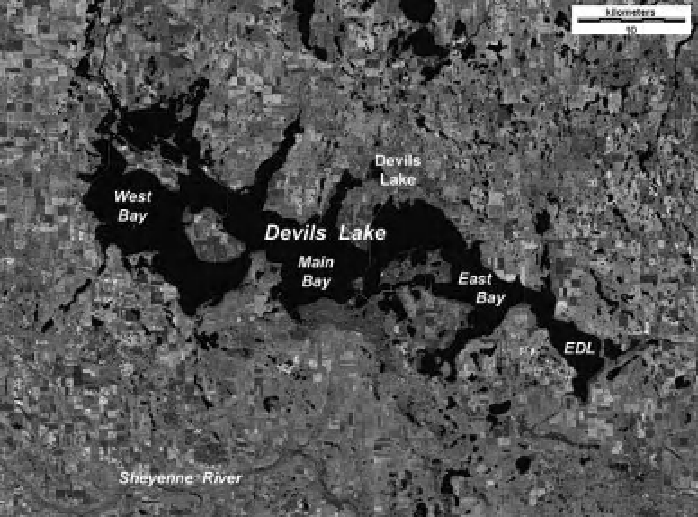Geoscience Reference
In-Depth Information
Figure 8-26.
Devils Lake vicinity, northeastern North Dakota, United States. Landsat TM band 5 (mid-infrared)
satellite image showing expanded extent of lakes, 8 September 2000. EDL
=
East Devils Lake, which was formerly a
separate lake (see Fig. 8-28). Image from NASA; processing by J.S. Aber.
climatic cooling
-
a positive feedback relation-
ship. A shift toward warmer, drier climate would
have the opposite consequence, again a positive
feedback situation. However, neither climate nor
wetlands behave in such simplistic ways. Con-
sider, for example, the northern Great Plains of
the United States. Climate has become gradually
warmer during the past half century in the
Dakotas and Minnesota. However, precipitation
has also increased, with major consequences for
wetlands, as demonstrated by frequent l ooding
of the Red River of the North and expansion of
Devils Lake in the northeast of North Dakota
(Fig. 8-26).
Devils Lake is a system of connected, large
lake basins scooped out during the last glaciation
of the region, some 14,000 to 12,000 years ago.
Lakes in the enclosed drainage basin are subject
to sizable changes in their elevation, area, capac-
ity, chemistry, and biomass (Aber et al. 1997).
These changes take place mainly in response to
climatic l uctuations. During the past half century,
Devils Lake has experienced a dramatic increase
in its surface elevation on the order of 40 feet
(12 m) with corresponding increases in surface
area and volume (Fig. 8-27).
Lake elevations above 1440 feet have led
to signii cant l ooding of adjacent cities, parks,
roads, farms, sewage treatment plants, a military
base, a Native American reservation, and other
human structures. This elevation was surpassed
in 1997, and Devils Lake reached 1446 feet
elevation during the summer of 1999, at which
point the lake overl owed and began draining
eastward into Stump Lake. Despite this outlet,
lake level has continued to rise and now exceeds
1450 feet (U.S. Geological Survey 2010). Count-
less smaller lakes and marshes in this vicinity
have responded in a similar fashion, which dem-
onstrates that global warming may have unex-
pected consequences on a regional basis, in this
case leading to greatly expanded wetland habi-
tats (Fig. 8-28).
One may look also at the micro-scale impact
of climate change (see Tables 3-1 and 2), for
example, in bogs of Estonia. During warm/dry
periods, hummocks and ridges are stable or
increasing, whereas bog hollows expand during
cool/wet climatic intervals (Karofeld 1998).
Frenzel and Karofeld (2000) demonstrated at
Männikjärve Bog (see Color Plate 3-10) that
hummocks and ridges are sinks for methane; in





